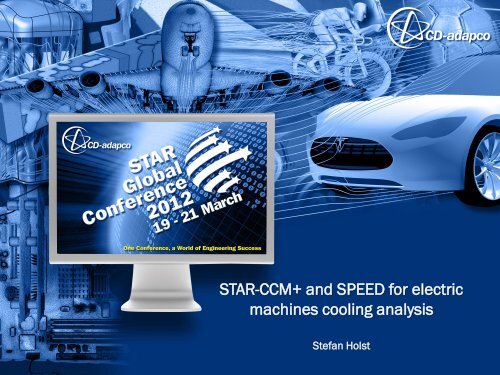STAR-CCM+ and SPEED for electric machines cooling analysis
STAR-CCM+ and SPEED for electric machines cooling analysis
STAR-CCM+ and SPEED for electric machines cooling analysis
- No tags were found...
You also want an ePaper? Increase the reach of your titles
YUMPU automatically turns print PDFs into web optimized ePapers that Google loves.
<strong>STAR</strong>-<strong>CCM+</strong> <strong>and</strong> <strong>SPEED</strong> <strong>for</strong> <strong>electric</strong><strong>machines</strong> <strong>cooling</strong> <strong>analysis</strong>Stefan Holst
Overview<strong>SPEED</strong>’s own thermal capability consists of simplified circuit models– Good <strong>for</strong> a first shot– Circuit model allows <strong>for</strong> quick <strong>analysis</strong> of duty cycle simulationsEfficiency requirements, space <strong>and</strong> weight restrictions lead to morecomplex machine <strong>and</strong> machine enclosure designs– Identifying hot spots becomes tricky– <strong>STAR</strong>-<strong>CCM+</strong> can show its strength in these modelsUser should benefit as much as possible from the work done in <strong>SPEED</strong>– Import geometry– Import distribution of heat loads electromagnetic losses– Future: coupled EMAG <strong>and</strong> thermal <strong>analysis</strong> in a single tool
Loss mechanisms <strong>and</strong> distributionOhmic heating in all conducting parts– Windings, laminated rotor <strong>and</strong> stator core <strong>and</strong> magnets– Winding/copper losses are usually the largest contributorHysteresis effects mostly in steel partsSimulation these effects directlyrequires coupled transient EMAG run– Very costly <strong>for</strong> a design calculationNote: Losses occur locally
Steinmetz Loss calculationAlternative to coupled simulation– Hysteresis <strong>and</strong> eddy currents are mostlydriven by changes in the magnetic field– Get magnetic field <strong>for</strong> various rotorpositions <strong>and</strong> attribute losses to size offield changes– Strong variation in the teethMagnets shield the rotor core
Workflow diagramInitial 2D Machine Layout•Per<strong>for</strong>m EMAG layout•Per<strong>for</strong>m thermal circuitsimulation of duty cycles 10-16nodesGeometry Import•Meshing automatically specified•Physical setup•Either CHT•Or EMAG•Or even coupledHeat Loads from <strong>SPEED</strong>•Import via <strong>STAR</strong>-<strong>CCM+</strong> file<strong>for</strong>mat *.sbd•Surface data needs to bemapped to volume
Geometry importxGDF & xDEF files contain the completeEMAG setup in XML• Currently only Geometry import• Future versions include physics <strong>and</strong>models <strong>for</strong> end-windings, skew
Cooling mechanismAir cooled– Exterior <strong>and</strong> interiorSpray <strong>cooling</strong> of the end windingsWater <strong>cooling</strong> around the stator– More on that now
Results <strong>for</strong> a <strong>cooling</strong> jacket around the statorHeat conduction, convection <strong>and</strong> radiation in the interior air1l/min water pumped throughHow to keep the rotor cool?
Introduce holes into the rotorFour CAD features later we’ve got holes in the rotorRemesh <strong>and</strong> further iterating gives
Data MapperLosses are given in 2D but the thermal simulation is in 3DData Mapper functionality extension to facilitate precise mapping even<strong>for</strong> skewed <strong>machines</strong> will come with 7.04– Improved mapping quality comparedto current nearest neighbourinterpolationThree mappings are defined here:– Rotor– Stator– Windings<strong>SPEED</strong> only provides total losses inmagnets
Support <strong>for</strong> end windingsExamples so far have been h<strong>and</strong> made 3D CAD constructions
Glimpse on the EMAG solverMagnetostatic runs <strong>for</strong> different rotor positions
Glimpse on the EMAG solverLow frequency electro-magnetic solver– Frequency/domain size determines applicability‣ An e-<strong>machines</strong> frequency range might not be allowed in areas like minedetection with far larger length scalesCoupled transient <strong>and</strong> magnetostatic mode– Magnetostatic can be coupled with motion to cater <strong>for</strong> loss calculationsNon-linear material support– <strong>SPEED</strong> model import brings in BH-curves– Tabular data or functional description– Isotropic <strong>electric</strong> conductivity <strong>and</strong> permeability
EMAG solver outlookCircuit– Transient 3D requires feedback from the circuit• Extend circuit capability in BSM <strong>for</strong> general use– Flux linkage report <strong>for</strong> electromagnetic circuit elementsField simulation– Hysteresis modeling• Residual magnetism– Force/Torque calculation– Anisotropy• Electric conductivity <strong>and</strong>permeability• Infrastructure
Thank youThank you!



